This time the wind was really blowing and I was glad that I had my smaller sail installed on my kayak: the SeaDog 0.7m².
I could feel that there was less heeling as I didn't have to transfer all my weight to the windy side.
My large sail of 1.0m² would have been too much and harder to handle while my SeaDog 0.7m² was still giving me plenty of speed to surf the waves with ease.
Here is a short video of a few different outings with the SeaDog 0.7m²
I believe that the SeaDog 0.7m² is a great sail for when the wind starts to blow and white caps appear on the water; it offers me plenty of power while still allowing me to handle my more tippy kayaks without a white-knuckled grip on my paddle.
I figured out that a kayak can only go so fast and no matter how big of a sail I mount on the deck it just won't go any faster.
A larger sail however just catches more wind and when loaded from the side wind it wants to push the kayak over. I have been at times hanging way over the side of my kayaks trying to keep them from tipping while not noticing any increase in speed over a smaller sail.
Of course, if the wind is from behind (stern wind) and the waves have built up to a size that they start to lift the stern of the kayak where I can surf; my kayak will indeed go faster than hull speed.
It is these times that I find the SeaDog 0.7m² exceptional and easier to handle.
As I surf down the wave (on a wind right behind me) the kayak will come to a point where the sail no longer seems to be inflated. At the bottom of the wave I will have the boom flap loose over the deck and wanting to swap sides. Then the gust of wind catches up with me and with a shuddering noise the sail slaps to the other side taken in by the main sheet.
It is in this moment that a smaller sail will save me from a sudden imbalance and possible precarious lean that might result in a dunk.
I don't feel the raw slap that bigger sails give me in high winds: the 0.7m² is easier to handle.
Another benefit of a smaller sail is when things do go pear shaped and I fall in.
I have been practicing rolling with a sail; starting from dead calm conditions to increased breezes and more bumpy seas.
I find that a sail with a smaller surface has much less drag underwater and in a roll I can scull up without too much effort.
Recently I have been trying to forego releasing the main sheet and just leave the sail alone while falling in. While slightly more difficult than releasing the main sheet (or uphaul) I am more confident in recovering with the sail just left as it was before falling in.
As winds increase to 20 knots and above I wonder if a smaller sail would not be even better?
Maybe that is something I should look into...
.
25 November 2014
17 November 2014
Vandal or innocent fun?
At my favorite camping spot I was confronted with this scene.
To paint the picture a bit I should mention that it is a National Park heavily frequented by motor boats; a popular destination for day trips or overnight camping; in other words a busy place, not remote at all.
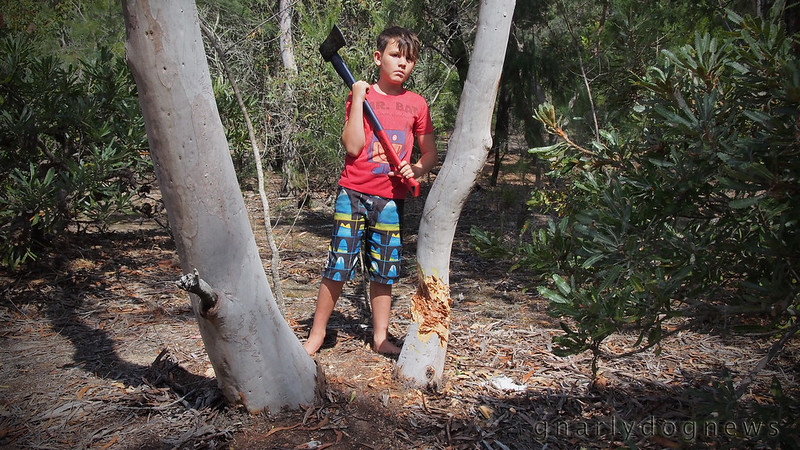
I did not know how to react and experience has taught me not to engage too much with somebody possibly not doing the right thing. My initial reaction was disbelief soon followed by anger: somebody was cutting down trees that offered shelter from the sun and wind, in a natural place pleasant enough that I often call home for a night or two.
But the best I could do was to keep my distance somehow and just take photographs.
Even though the youngster did not look too menacing, my camera is no match for an axe; if not used by the youth, certainly by the parent not too far away.
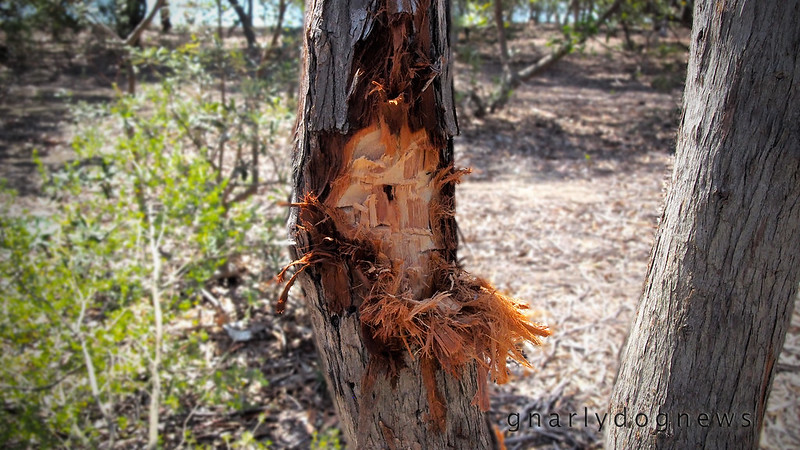
There were a dozen trees that have been freshly cut, some a bit too large that seem to have deterred the short attention span of the kid that found attacking smaller ones more rewarding.
The child was still hacking away when I got near him but then he stopped and watched me for a while.
I am not sure what went through his head and if he felt that a camera on the scene might have prompted to review his actions.
It was not long before the adults arrived to see why the chopping stopped.
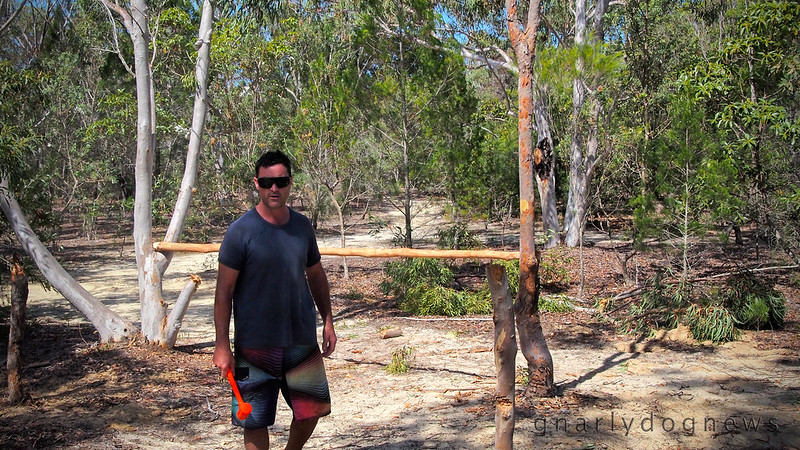
I was asked what I was doing and I explained that I was photographing.
Again the older man wanted to know what for and I revealed that it was for documentation.
Hammer in hand he stepped closer to me and asked: What for?
I explained that somebody might be interested in my images, suggesting the ranger.
At this point the vibe changed and I could sense a shift in emotions.
The hammer holding man tried to convince me in a loud voice that his kid was just having fun and that I was not allowed to take pictures.
Soon a little group gathered (friends of the man) and started to shout rather insulting remarks.
It was clear to me that it would not be wise to try to explain my view, after all I was quickly labelled pedophile and pervert and police was going to be called in.
I thanked them for their decision to actually call the police as maybe a few things could be cleared but I never saw the arrival of any law enforcement.
I also knew that it was time to retreat, clearly outnumbered by menacing little crowd.
I walked away happy that despite my rage I was able to remain calm and not engage: it was not my place to prevent trees getting cut down.
Somehow maybe my presence and the fact of me taking images deterred the kid from continuing and the ax was put away: damage was done but at least not continued.
I feel sad that the child lives in ignorance and cuts trees down in a National Park, right where so many others try to enjoy the place. It makes me wonder what messages has he learned at school, or is the influence of his father stronger than what I hope the educational system has given him?
The other part in me also acknowledges that it could have been intended as innocent fun to build a cubby house (his father's words), just maybe in the wrong environment?
Later in the afternoon I suddenly heard a chain saw fired up and the shrieking sound of trees getting cut down at the other side of the camp.
This time, I was not going trying to document the event.
A kid with and axe is one thing, somebody waving a chainsaw at me is a bit different, especially if alcohol is involved...
.
To paint the picture a bit I should mention that it is a National Park heavily frequented by motor boats; a popular destination for day trips or overnight camping; in other words a busy place, not remote at all.

I did not know how to react and experience has taught me not to engage too much with somebody possibly not doing the right thing. My initial reaction was disbelief soon followed by anger: somebody was cutting down trees that offered shelter from the sun and wind, in a natural place pleasant enough that I often call home for a night or two.
But the best I could do was to keep my distance somehow and just take photographs.
Even though the youngster did not look too menacing, my camera is no match for an axe; if not used by the youth, certainly by the parent not too far away.

There were a dozen trees that have been freshly cut, some a bit too large that seem to have deterred the short attention span of the kid that found attacking smaller ones more rewarding.
The child was still hacking away when I got near him but then he stopped and watched me for a while.
I am not sure what went through his head and if he felt that a camera on the scene might have prompted to review his actions.
It was not long before the adults arrived to see why the chopping stopped.

I was asked what I was doing and I explained that I was photographing.
Again the older man wanted to know what for and I revealed that it was for documentation.
Hammer in hand he stepped closer to me and asked: What for?
I explained that somebody might be interested in my images, suggesting the ranger.
At this point the vibe changed and I could sense a shift in emotions.
The hammer holding man tried to convince me in a loud voice that his kid was just having fun and that I was not allowed to take pictures.
Soon a little group gathered (friends of the man) and started to shout rather insulting remarks.
It was clear to me that it would not be wise to try to explain my view, after all I was quickly labelled pedophile and pervert and police was going to be called in.
I thanked them for their decision to actually call the police as maybe a few things could be cleared but I never saw the arrival of any law enforcement.
I also knew that it was time to retreat, clearly outnumbered by menacing little crowd.
I walked away happy that despite my rage I was able to remain calm and not engage: it was not my place to prevent trees getting cut down.
Somehow maybe my presence and the fact of me taking images deterred the kid from continuing and the ax was put away: damage was done but at least not continued.
I feel sad that the child lives in ignorance and cuts trees down in a National Park, right where so many others try to enjoy the place. It makes me wonder what messages has he learned at school, or is the influence of his father stronger than what I hope the educational system has given him?
The other part in me also acknowledges that it could have been intended as innocent fun to build a cubby house (his father's words), just maybe in the wrong environment?
Later in the afternoon I suddenly heard a chain saw fired up and the shrieking sound of trees getting cut down at the other side of the camp.
This time, I was not going trying to document the event.
A kid with and axe is one thing, somebody waving a chainsaw at me is a bit different, especially if alcohol is involved...
.
11 November 2014
Video: Radikal Kayak Surfing
I love this video.
Beside the incredibly smooth kayak surfing demonstrating outstanding skills using an unconventional paddle, the footage capture and the editing is really captivating.
It inspires me to get out more in the rough stuff and play.
My aspirations: to be one day half as good as Marc.
.
Beside the incredibly smooth kayak surfing demonstrating outstanding skills using an unconventional paddle, the footage capture and the editing is really captivating.
It inspires me to get out more in the rough stuff and play.
My aspirations: to be one day half as good as Marc.
.
07 November 2014
Photo: candle lit tent
.
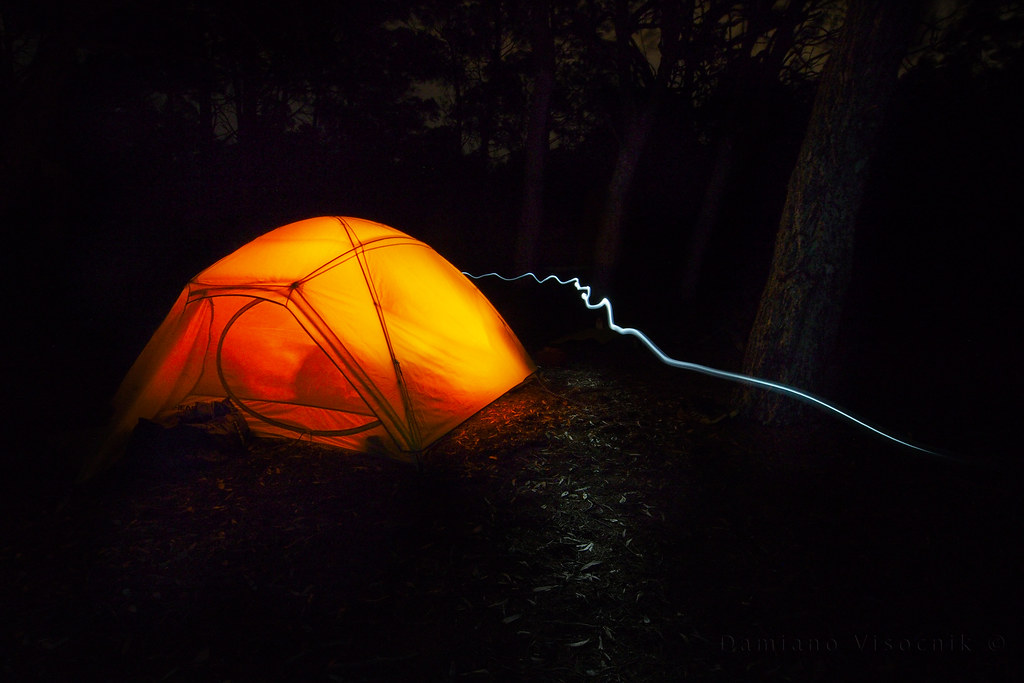
First outing with the new "summer tent".
I need a roomy tent for tropical conditions, for when the nights are humid and hot, or for when it's raining. Small tents are a sauna in the Queensland heat and ventilation is critical.
While not super light (2.7Kg) and not very compact it still allows me enough elbow room for maybe a game of cards with a few buddies?
I got this one for a steal at REI...

First outing with the new "summer tent".
I need a roomy tent for tropical conditions, for when the nights are humid and hot, or for when it's raining. Small tents are a sauna in the Queensland heat and ventilation is critical.
While not super light (2.7Kg) and not very compact it still allows me enough elbow room for maybe a game of cards with a few buddies?
I got this one for a steal at REI...
03 November 2014
GEAR: cheap light stoves
.
There are a few things easier than cooking on a gas stove when camping, eating cold food is one.
I love the simplicity of canister gas stoves: turn the control knob, light the flame and we are "cooking with gas"
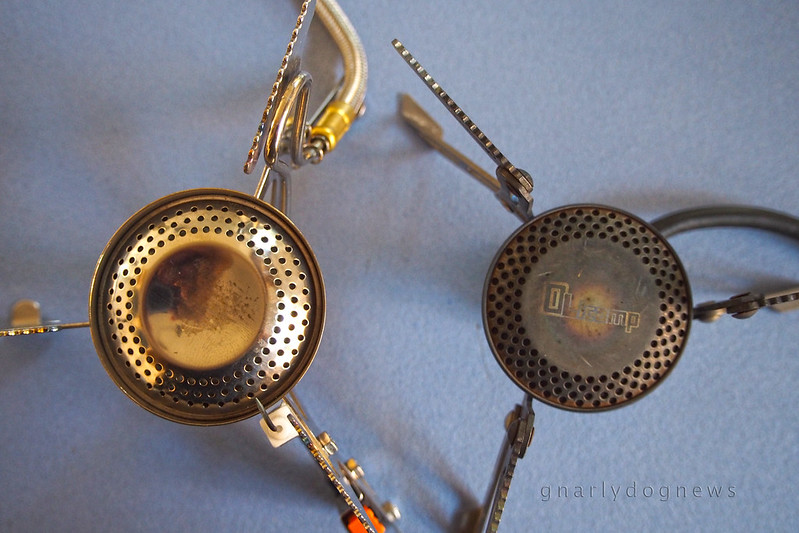
I have made a previous post about the virtues of compact gas stove here.
I have since updated my stoves and opted for something that is stable but still light.
I prefer to cook with non-dedicated pots that are not part of a system (with flux ring, like JetBoil and MSR Reactor).
I like the flexibility of being able to use a small frying pan (that I picked up at K-Mart for under $10) when a fancy dinner or breakfast is in order.
Therefore I looked at stoves that are close to the ground, have a decent footprint for stability and have a large burner (Pocket Rocket's small burner head scorches light pots).
Above are two stoves: left is a very cheap one in stainless steel from eBay, right a bit more expensive one in titanium.

For the last 18 months I have been using a light titanium stove that sits low to the ground. At 100gr. is very light, packs away small and shows no signs of rust.
The stove is so light that a small movement of the flexible hose tips it over if no pot is on the stove
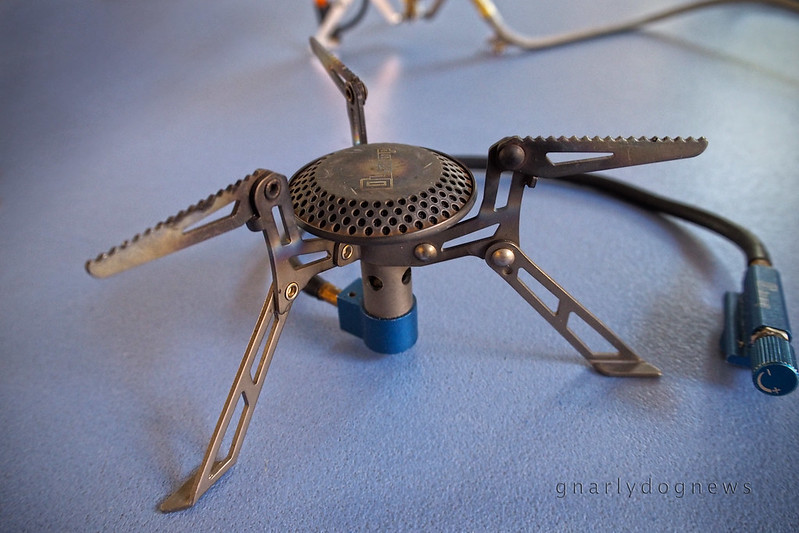
I have used this stove for approximately 100 days, cooking extensively meals for two, occasionally for 4.
Coupled with a light windshield (very thin aluminium sheet) it has worked well in above freezing temps, even in very windy locations. The windshield is critical when there is a breeze as it retains heat and saves fuel.
When cranked to the max the stove roars and emits too much heat; I usually have it regulated at about half power.
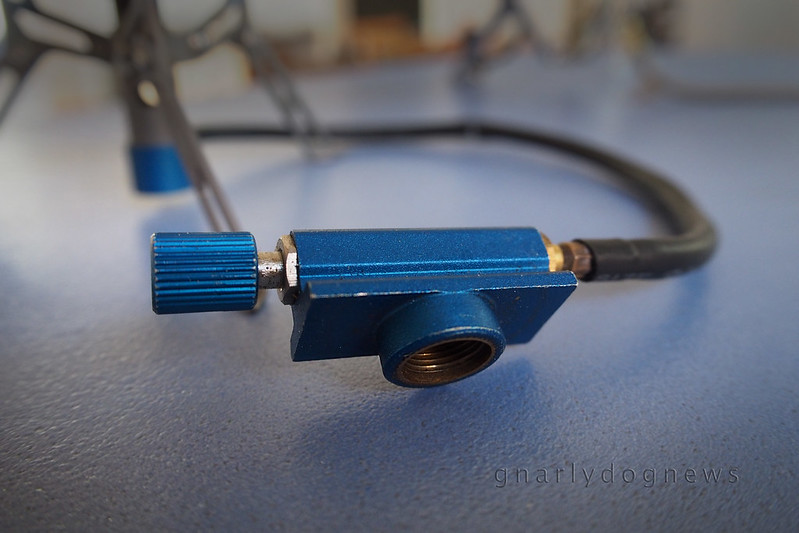
The flame control knob is at the canister spigot, away from the heat of the burner and easy to adjust when the stove is going. I like that: no burned fingers trying to reduce the flame when I feel my risotto is about to get scorched.

But there is little fault: the hose junction into the base of the burner's jet.
While the hose does have an O ring on the shaft of the hose intersecting the (blue) aluminum base, the hose can not freely rotate. A slight redesign would make this stove even better.
Trolling on eBay I came across this stove: a compact stainless steel design with large burner (did I mention I don't care for burned food?).
Labelled as "Lingyun portable gas butane stove..." I was impressed by the price: $17.99
I ordered one as I thought it would be great as a back-up stove.
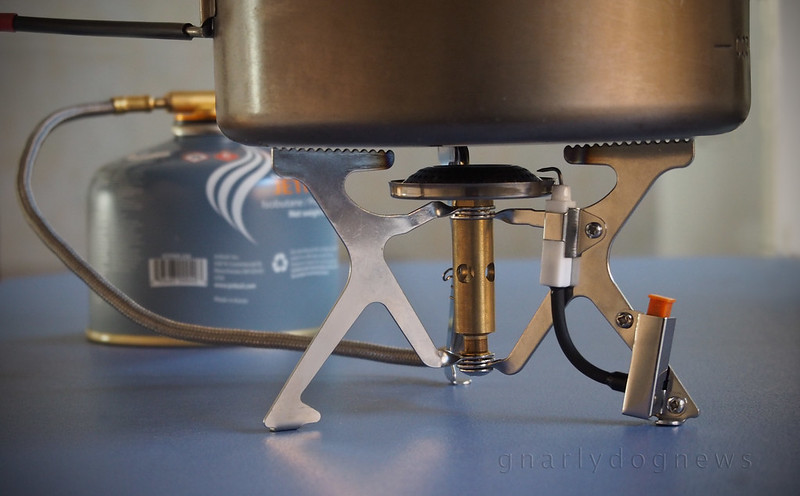
The difference on this one are the legs, the fuel supply and the ignition.
I don't care about the piezo ignition where the stove can be started by just pressing a button: my experience is that they don't last. Luckily I can unbolt the unit when it will stopped working and use my trusty BIC lighter.
The legs of the stove are however made of one-piece sheet metal; they can not be accidentally folded and collapsed while operating the stove making this unit a bit more sturdy, requiring less care.
The downside is that this stove is not as compact as the titanium one, when stowed.
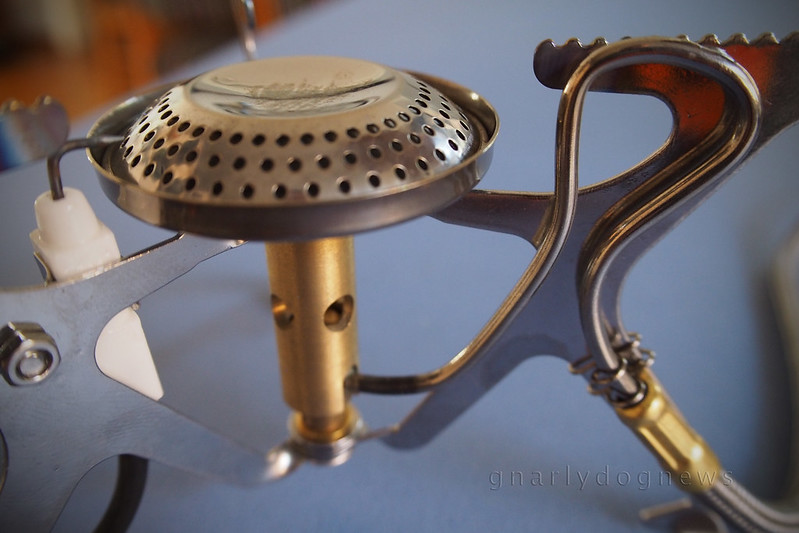
Last but not least the fuel supply.
The gas travels from the canister to the stove via a flexible hose and then, just before reaching the jet is makes a loop of solid pipe passing close to the flame area.
It is intended to vaporize the butane/propane gas before it reaches the jet when ambient temperatures are low, close and below freezing.
While not really a concern to most sea kayakers in tropical locations, outdoor users in colder environments lament poor performance of gas canister stoves when temps are chilly.
The preheating loop takes care of that and delivers hot gas to the burner (once the stove has been operating for a minute or so).
And while I write about gas stoves I should mention this little adapter.
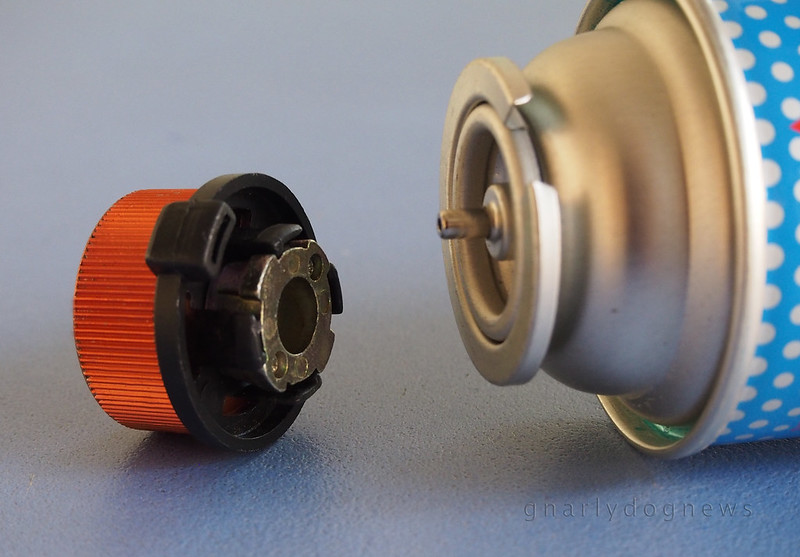
*If you run the canister sideways with the notch up, your canister will deliver fuel vapors. If you run the canister with the notch pointed down, your canister will deliver liquid fuel.
The gas canister stoves use a Lindal valve, where the stove or regulator are screwed-on to create a leak-proof seal. Gas canisters are usually a mix of butane/propane for better performance in low temperatures. They are readily available at good outdoor stores but not so easy to find elsewhere.
I had a bit of trouble locating the Lindal valve canisters in Sweden but I saw plenty of push-on style butane cans.
Again, on eBay I was able to source an adapter that allows screw-on stoves to be used with the much cheaper ($5 for 4 cans) option of push-on cans.
The push-on cans are often just basic butane, more suited for warm climates; however I have also seen the butane/propane mix ones.

And to get that gas stove working well in windy places (cooking inside the tent is a bad idea) I sourced a matching windshield.
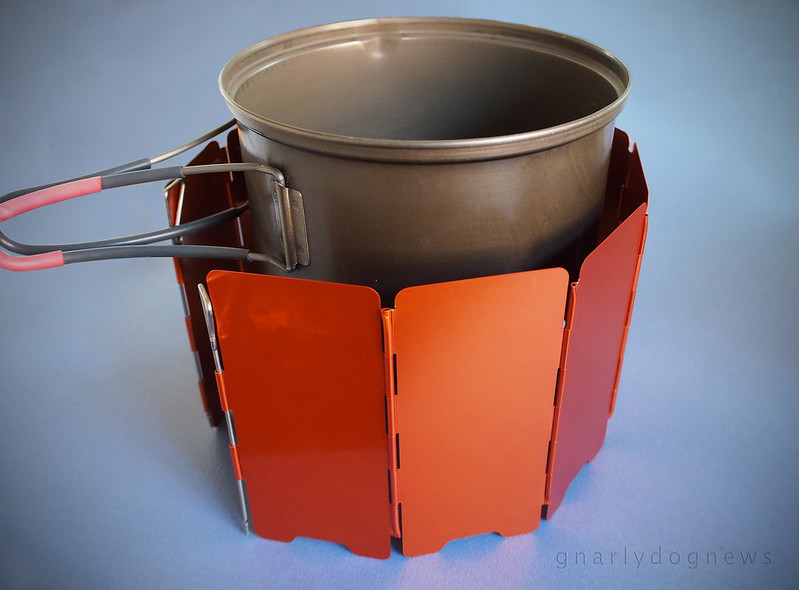
This shield is a bit heavier than my super thin one that I have used for decades, the advantage is that it has little spikes that can be driven into the ground to keep the stove and shield well connected.

.
There are a few things easier than cooking on a gas stove when camping, eating cold food is one.
I love the simplicity of canister gas stoves: turn the control knob, light the flame and we are "cooking with gas"

I have made a previous post about the virtues of compact gas stove here.
I have since updated my stoves and opted for something that is stable but still light.
I prefer to cook with non-dedicated pots that are not part of a system (with flux ring, like JetBoil and MSR Reactor).
I like the flexibility of being able to use a small frying pan (that I picked up at K-Mart for under $10) when a fancy dinner or breakfast is in order.
Therefore I looked at stoves that are close to the ground, have a decent footprint for stability and have a large burner (Pocket Rocket's small burner head scorches light pots).
Above are two stoves: left is a very cheap one in stainless steel from eBay, right a bit more expensive one in titanium.

For the last 18 months I have been using a light titanium stove that sits low to the ground. At 100gr. is very light, packs away small and shows no signs of rust.
The stove is so light that a small movement of the flexible hose tips it over if no pot is on the stove

I have used this stove for approximately 100 days, cooking extensively meals for two, occasionally for 4.
Coupled with a light windshield (very thin aluminium sheet) it has worked well in above freezing temps, even in very windy locations. The windshield is critical when there is a breeze as it retains heat and saves fuel.
When cranked to the max the stove roars and emits too much heat; I usually have it regulated at about half power.

The flame control knob is at the canister spigot, away from the heat of the burner and easy to adjust when the stove is going. I like that: no burned fingers trying to reduce the flame when I feel my risotto is about to get scorched.

But there is little fault: the hose junction into the base of the burner's jet.
While the hose does have an O ring on the shaft of the hose intersecting the (blue) aluminum base, the hose can not freely rotate. A slight redesign would make this stove even better.
Trolling on eBay I came across this stove: a compact stainless steel design with large burner (did I mention I don't care for burned food?).
Labelled as "Lingyun portable gas butane stove..." I was impressed by the price: $17.99
I ordered one as I thought it would be great as a back-up stove.

The difference on this one are the legs, the fuel supply and the ignition.
I don't care about the piezo ignition where the stove can be started by just pressing a button: my experience is that they don't last. Luckily I can unbolt the unit when it will stopped working and use my trusty BIC lighter.
The legs of the stove are however made of one-piece sheet metal; they can not be accidentally folded and collapsed while operating the stove making this unit a bit more sturdy, requiring less care.
The downside is that this stove is not as compact as the titanium one, when stowed.

Last but not least the fuel supply.
The gas travels from the canister to the stove via a flexible hose and then, just before reaching the jet is makes a loop of solid pipe passing close to the flame area.
It is intended to vaporize the butane/propane gas before it reaches the jet when ambient temperatures are low, close and below freezing.
While not really a concern to most sea kayakers in tropical locations, outdoor users in colder environments lament poor performance of gas canister stoves when temps are chilly.
The preheating loop takes care of that and delivers hot gas to the burner (once the stove has been operating for a minute or so).
And while I write about gas stoves I should mention this little adapter.

*If you run the canister sideways with the notch up, your canister will deliver fuel vapors. If you run the canister with the notch pointed down, your canister will deliver liquid fuel.
The gas canister stoves use a Lindal valve, where the stove or regulator are screwed-on to create a leak-proof seal. Gas canisters are usually a mix of butane/propane for better performance in low temperatures. They are readily available at good outdoor stores but not so easy to find elsewhere.
I had a bit of trouble locating the Lindal valve canisters in Sweden but I saw plenty of push-on style butane cans.
Again, on eBay I was able to source an adapter that allows screw-on stoves to be used with the much cheaper ($5 for 4 cans) option of push-on cans.
The push-on cans are often just basic butane, more suited for warm climates; however I have also seen the butane/propane mix ones.

And to get that gas stove working well in windy places (cooking inside the tent is a bad idea) I sourced a matching windshield.

This shield is a bit heavier than my super thin one that I have used for decades, the advantage is that it has little spikes that can be driven into the ground to keep the stove and shield well connected.

.
